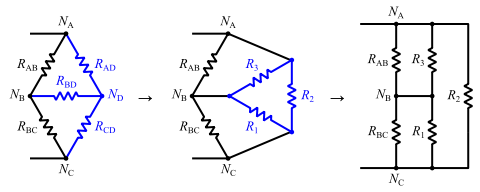Basic Y-Δ transformation
The transformation is used to establish equivalence for networks with three terminals. Where three elements terminate at a common node and none are sources, the node is eliminated by transforming the impedances. For equivalence, the impedance between any pair of terminals must be the same for both networks. The equations given here are valid for complex as well as real impedances.
Equations for the transformation from Δ to Y
The general idea is to compute the impedance at a terminal node of the Y circuit with impedances , to adjacent nodes in the Δ circuit by
where are all impedances in the Δ circuit. This yields the specific formulae
Equations for the transformation from Y to Δ
The general idea is to compute an impedance in the Δ circuit by
where is the sum of the products of all pairs of impedances in the Y circuit and is the impedance of the node in the Y circuit which is opposite the edge with . The formula for the individual edges are thus
Circuit Analysis: Techniques for Solving Δ to Y
A circuit that has a combination of Δ-loads and Y-loads should be converted to the Y configuration. By converting from Δ to Y, each circuit element can be analyzed separately. Converting from Δ to Y is a technique aimed to simplify circuit analysis. (Note: harmonic behavior from the original circuit remained unchanged). The conversion from the Δ notation to Y notation is as follows:
A proof of the existence and uniqueness of the transformation
The feasibility of the transformation can be shown as a consequence of the superposition theorem for electric circuits. A short proof, rather than one derived as a corollary of the more general star-mesh transform, can be given as follows. The equivalence lies in the statement that for any external voltages ( and ) applying at the three nodes ( and ), the corresponding currents (and ) are exactly the same for both the Y and Δ circuit, and vice versa. In this proof, we start with given external currents at the nodes. According to the superposition theorem, the voltages can be obtained by studying the linear summation of the resulting voltages at the nodes of the following three problems applied at the three nodes with current:
- (1)
- (2) and
- (3)
It can be readily shown by Kirchhoff's circuit laws that . One notes that now each problem is relatively simple, since it involves only one single ideal current source. To obtain exactly the same outcome voltages at the nodes for each problem, the equivalent resistances in the two circuits must be the same, this can be easily found by using the basic rules of series and parallel circuits:
Though usually six equations are more than enough to express three variables () in term of the other three variables(), here it is straightforward to show that these equations indeed lead to the above designed expressions. In fact, the superposition theorem not only establishes the relation between the values of the resistances, but also guarantees the uniqueness of such solution.
Simplification of networks
Resistive networks between two terminals can theoretically be simplified to a single equivalent resistor (more generally, the same is true of impedance). Series and parallel transforms are basic tools for doing so, but for complex networks such as the bridge illustrated here, they do not suffice.
The Y-Δ transform can be used to eliminate one node at a time and produce a network that can be further simplified, as shown.
The reverse transformation, Δ-Y, which adds a node, is often handy to pave the way for further simplification as well.
Every two-terminal network represented by a planar graph can be reduced to a single equivalent resistor by a sequence of series, parallel, Y-Δ, and Δ-Y transformations.[3] However, there are non-planar networks that cannot be simplified using these transformations, such as a regular square grid wrapped around a torus, or any member of the Petersen family.
Graph theory[edit]
In graph theory, the Y-Δ transform means replacing a Y subgraph of a graph with the equivalent Δ subgraph. The transform preserves the number of edges in a graph, but not the number of vertices or the number of cycles. Two graphs are said to be Y-Δ equivalent if one can be obtained from the other by a series of Y-Δ transforms in either direction. For example, the Petersen family is a Y-Δequivalence class.
Demonstration
Δ-load to Y-load transformation equations
To relate from Δ to from Y, the impedance between two corresponding nodes is compared. The impedance in either configuration is determined as if one of the nodes is disconnected from the circuit.
The impedance between N1 and N2 with N3 disconnected in Δ:
To simplify, let be the sum of .
Thus,
The corresponding impedance between N1 and N2 in Y is simple:
hence:
- (1)
Repeating for :
- (2)
and for :
- (3)
From here, the values of can be determined by linear combination (addition and/or subtraction).
For example, adding (1) and (3), then subtracting (2) yields
thus,
where
For completeness:
- (4)
- (5)
- (6)
Y-load to Δ-load transformation equations
Let
- .
We can write the Δ to Y equations as
- (1)
- (2)
- (3)
Multiplying the pairs of equations yields
- (4)
- (5)
- (6)
and the sum of these equations is
- (7)
Factor from the right side, leaving in the numerator, canceling with an in the denominator.
- (8)
Note the similarity between (8) and {(1),(2),(3)}
Divide (8) by (1)
which is the equation for . Dividing (8) by (2) or (3) (expressions for or ) gives the remaining equations.

 at a terminal node of the Y circuit with impedances
at a terminal node of the Y circuit with impedances  ,
,  to adjacent nodes in the Δ circuit by
to adjacent nodes in the Δ circuit by
 are all impedances in the Δ circuit. This yields the specific formulae
are all impedances in the Δ circuit. This yields the specific formulae

 is the sum of the products of all pairs of impedances in the Y circuit and
is the sum of the products of all pairs of impedances in the Y circuit and  is the impedance of the node in the Y circuit which is opposite the edge with
is the impedance of the node in the Y circuit which is opposite the edge with 

 and
and  ) applying at the three nodes (
) applying at the three nodes ( and
and  ), the corresponding currents (
), the corresponding currents ( and
and  ) are exactly the same for both the Y and Δ circuit, and vice versa. In this proof, we start with given external currents at the nodes. According to the superposition theorem, the voltages can be obtained by studying the linear summation of the resulting voltages at the nodes of the following three problems applied at the three nodes with current:
) are exactly the same for both the Y and Δ circuit, and vice versa. In this proof, we start with given external currents at the nodes. According to the superposition theorem, the voltages can be obtained by studying the linear summation of the resulting voltages at the nodes of the following three problems applied at the three nodes with current:
 and
and
 . One notes that now each problem is relatively simple, since it involves only one single ideal current source. To obtain exactly the same outcome voltages at the nodes for each problem, the equivalent resistances in the two circuits must be the same, this can be easily found by using the basic rules of
. One notes that now each problem is relatively simple, since it involves only one single ideal current source. To obtain exactly the same outcome voltages at the nodes for each problem, the equivalent resistances in the two circuits must be the same, this can be easily found by using the basic rules of 

 ) in term of the other three variables(
) in term of the other three variables( ), here it is straightforward to show that these equations indeed lead to the above designed expressions. In fact, the superposition theorem not only establishes the relation between the values of the resistances, but also guarantees the uniqueness of such solution.
), here it is straightforward to show that these equations indeed lead to the above designed expressions. In fact, the superposition theorem not only establishes the relation between the values of the resistances, but also guarantees the uniqueness of such solution.


 from Δ to
from Δ to  from Y, the impedance between two corresponding nodes is compared. The impedance in either configuration is determined as if one of the nodes is disconnected from the circuit.
from Y, the impedance between two corresponding nodes is compared. The impedance in either configuration is determined as if one of the nodes is disconnected from the circuit.
 be the sum of
be the sum of 


 (1)
(1) :
: (2)
(2) :
: (3)
(3)


 (4)
(4) (5)
(5) (6)
(6) (3)
(3) (4)
(4) (5)
(5) (6)
(6) (7)
(7) from the right side, leaving
from the right side, leaving 
 (8)
(8)

 . Dividing (8) by (2) or (3) (expressions for
. Dividing (8) by (2) or (3) (expressions for  or
or  ) gives the remaining equations.
) gives the remaining equations.
No comments:
Post a Comment